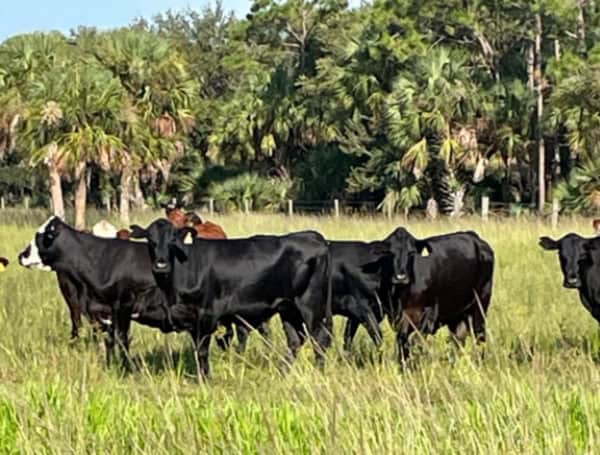The Florida Department of Agriculture and Consumer Services (FDACS) is sounding the alarm, urging veterinarians, livestock producers, and animal health professionals across the state to be on high alert for signs of the New World screwworm. This warning comes as the threat of the parasitic fly spreading into the United States intensifies.
According to FDACS, the New World screwworm poses a significant risk to U.S. livestock, wildlife, and domestic animals, particularly those crucial to the food system, such as beef and dairy cattle. Florida, with its warm climate and substantial animal populations, is considered especially vulnerable.
The growing concern stems from the screwworm’s spread northward from Panama through Southern Mexico. In response to this increasing proximity, the United States Department of Agriculture (USDA) took action on Sunday, suspending all live cattle, horse, and bison imports from Mexico.
RELATED: Florida Officials Issue Alert As Destructive New World Screwworm Approaches US Border From Mexico
To provide crucial information about this potential threat, experts at the University of Florida (UF) have offered insights into the New World screwworm, its history in the U.S., and how to identify infections in animals.
The New World screwworm, scientifically known as Cochliomyia hominivorax, is a type of fly whose larval stage, the maggot, presents the primary danger. Unlike most maggots that feed on dead tissue, the New World screwworm maggot aggressively consumes the living flesh of warm-blooded animals.
“Using an existing wound as a point of entry, they can burrow into a living animal with an existing open wound and cause serious, sometimes deadly, damage to the animal,” explained Andrew Short, chair of the UF/IFAS Department of Entomology and Nematology. The screwworm can infest a wide range of warm-blooded animals, including livestock, pets, wildlife, and even, in rare instances, people. Animals with recent wounds or those that have just undergone surgery are at heightened risk.
READ: Florida Agriculture Gets Major Water Quality Boost: Simpson Announces BMP Manual Updates
The New World screwworm was present in the U.S. from before the Civil War until its successful eradication in 1966, according to Short.
However, the threat of re-emergence remains. A stark reminder of this occurred in 2016 when an infection spread through the Key deer population in the Florida Keys. This outbreak was eventually contained in early 2017 through the release of sterile flies. Currently, there are no reported cases of New World screwworms in the U.S.
Fortunately, New World screwworm infections can be treated. In humans and domesticated animals, treatment typically involves medical or veterinary procedures to physically remove the larvae. In wildlife, control efforts focus on eliminating the screwworm fly population from the affected environment.
The primary method for eradicating New World screwworms from an area involves releasing large numbers of sterilized male flies. When these sterile flies mate with the local fertile screwworm population, the resulting eggs do not hatch, effectively halting reproduction and causing the population to die out over time.
Early detection is crucial in preventing a widespread outbreak. According to FDACS and UF experts, symptoms of a New World screwworm infection in animals can include:
- Irritated behavior, particularly around a wound.
- Head shaking and biting at an open wound.
- The distinct smell of tissue decay emanating from the wound.
- The presence of maggots within the wound.
- A large, red, raised area on the skin caused by fly strike.
- Signs of depression, such as a loss of appetite.
- Decreased milk production in livestock.
- Seclusion from the rest of the herd.
Dr. Fiona Maunsell, a clinical associate professor at the UF College of Veterinary Medicine, emphasized that while early symptoms can be subtle, the most telling sign is a change in the wound’s appearance. Infected wounds tend to become larger and deeper, often accompanied by a foul odor and bloody discharge.
Immediate Action is Crucial
Animal and livestock owners who suspect a screwworm infection must isolate the affected animal immediately and contact their veterinarian without delay. Concerns should also be reported to the State Veterinarian’s office. Dr. Maunsell strongly advised against treating a maggot-infested wound without first consulting a veterinarian or the State Veterinarian’s office, as this could hinder rapid detection and control efforts.
READ: Trust In Scientific Experts Key To Public Support For AI In Agriculture, UF/IFAS Study Finds
While all warm-blooded animals are susceptible, those that spend significant time outdoors, especially those giving birth outside, face a higher risk due to potential open wounds. To minimize the risk, owners are advised to keep wounds clean and covered and promptly report any signs of illness to their veterinarian.
How to Report a Suspected Infection
Florida State Veterinarian Dr. Michael Short stressed the importance of early detection and reporting in an FDACS press release. “The earlier we catch a potential case, the better chance we have of containing it,” he stated. “We’re asking everyone who works with animals, whether in private practice or in the field, to take a second look at any wound that is unusual or doesn’t heal as expected.”
To report suspected cases of New World screwworm infection in livestock or pets, please contact FDACS through the following channels:
- Phone: 850-410-0900 (during office hours) or 800-342-5869 (after hours)
- Email: RAD@FDACS.gov
- Online: www.FDACS.gov/RAD
Please make a small donation to the Tampa Free Press to help sustain independent journalism. Your contribution enables us to continue delivering high-quality, local, and national news coverage.
Connect with us: Follow the Tampa Free Press on Facebook and Twitter for breaking news and updates.
Sign up: Subscribe to our free newsletter for a curated selection of top stories delivered straight to your inbox.

